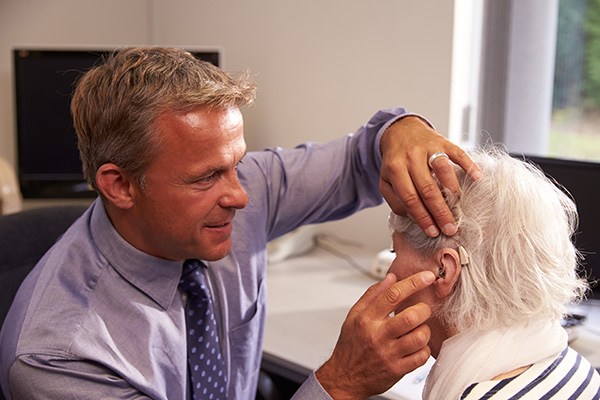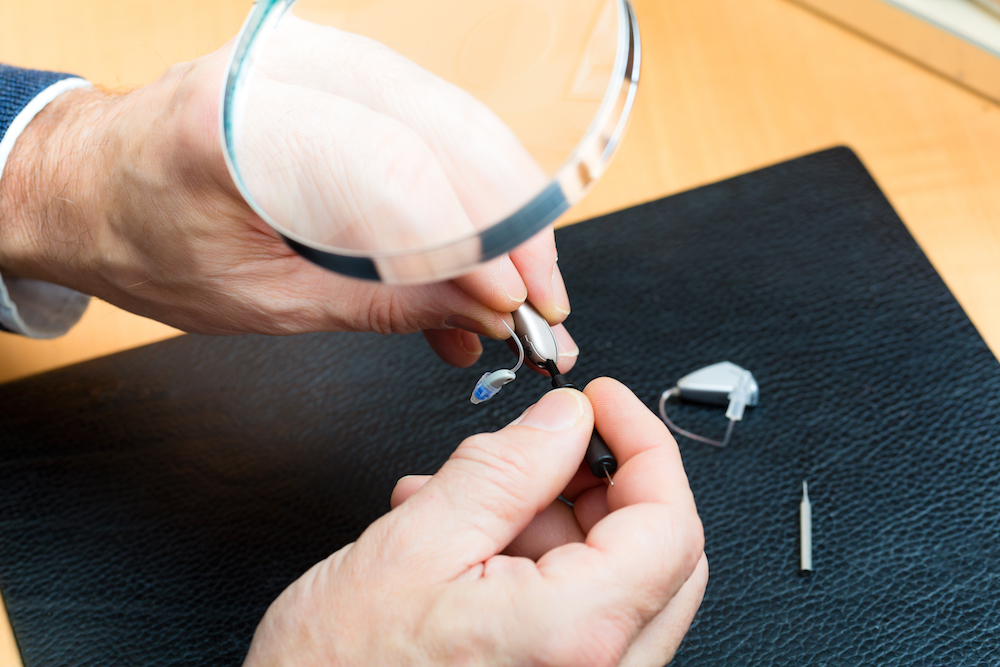Top Reasons to Schedule a Hearing Test
Everyone should have their hearing tested once in a while, and you should

By: admin | August 21, 2025
Hearing aids have come a long way from the basic devices that simply made everything louder. Today’s models can tell the difference between your voice and background noise, automatically adjust when you walk from a quiet coffee shop into a busy street, and even stream phone calls directly to your ears. They learn your preferences over time and adapt to your daily routines without you having to constantly fidget with settings or worry about whether they’re working properly in different situations. What used to require manual adjustments and frequent visits to your audiologist can now happen automatically throughout your day.
This shift toward smarter hearing aids reflects what people actually want from these devices. Nobody wants to spend their time thinking about their hearing aids or struggling to hear clearly in different environments. The growing market for these advanced devices shows that people are willing to invest in technology that genuinely makes their daily lives easier and more enjoyable. As manufacturers continue developing new features and capabilities, we’re seeing hearing aids become less like traditional medical equipment and more like helpful personal technology that works quietly in the background to improve your overall quality of life.
Smart hearing aids are different from traditional ones because they use technology that responds to your environment in real time. Instead of making all sounds louder, they can adjust based on where you are and what you’re listening to, helping conversations sound clearer and background noise feel less distracting. This creates a listening experience that feels more natural and less like you’re just turning up the volume on everything.
Another big difference is how they adapt without you having to constantly change settings. With older hearing aids, you might have to manually adjust the volume or switch programs when moving from a quiet room to a busy restaurant. Smart hearing aids can do this on their own, so you can focus more on the moment instead of on your device.
They can also get better the more you use them. Over time, smart hearing aids can learn from your preferences and the situations you’re in most often, creating a setup that fits your routines and comfort. The result is a more personal listening experience that works with your daily life instead of interrupting it.
Hearing aids have come a long way since their earliest beginnings. The first devices were simple ear trumpets, large funnels designed to collect sound and direct it into the ear. Although they helped amplify sounds somewhat, these devices were bulky and limited in their effectiveness. The introduction of electric hearing aids in the early 1900s marked a significant shift, offering more reliable amplification, though early models remained quite large and cumbersome.
The technology continued to improve throughout the 20th century. Vacuum tube hearing aids in the 1920s and 30s provided stronger sound amplification but were still relatively large. The real breakthrough came with the invention of the transistor in the 1950s, which made hearing aids smaller, more portable and easier to use daily. Later, the move to digital technology in the 1990s and 2000s brought improved sound clarity, better noise filtering and customization options tailored to individual hearing needs.
Important milestones include:
People are choosing smart hearing aids for the control and convenience they offer. These devices connect directly to smartphones, making it easy to adjust settings or stream calls and music. This keeps you connected with friends and family in a natural way.
Smart hearing aids also help you hear clearly in busy places like restaurants or group gatherings. Features like automatic noise reduction and real-time sound adjustments help you follow conversations without extra effort. The ability to filter out background noise gives you more confidence in social situations.
Hearing aid design has seen significant changes over the years, focusing on both comfort and discretion. Early hearing aids were often bulky and noticeable, making many users self-conscious about wearing them. Today’s devices are much smaller and lighter, designed to fit comfortably behind or inside the ear without drawing attention. Advances in materials have played a big role in this evolution, allowing manufacturers to create durable, skin-friendly and moisture-resistant components that hold up well to daily wear and outdoor activities.
Materials like hypoallergenic plastics and silicone have improved the fit and feel of hearing aids. Custom molds made from soft, flexible materials help ensure a secure and comfortable fit while reducing irritation. These materials also provide a better seal in the ear canal, which helps with sound quality by minimizing outside noise. Additionally, hearing aids now often include coatings or treatments that resist sweat, moisture and earwax buildup, extending the life of the device and reducing maintenance needs.
Design updates have also focused on wearer convenience. Devices are crafted to be easy to handle, even for those with limited dexterity, with features like simple buttons, rechargeable batteries and wireless connectivity. The overall goal has been to create hearing aids that not only improve hearing but also fit smoothly into daily life without hassle or discomfort. These improvements in design and materials have made wearing hearing aids a more comfortable and natural experience for many people.
Advances in hearing aid technology have transformed how these devices support your hearing every day. Modern hearing aids offer features that adapt to different listening environments, connect seamlessly with your other devices and provide clearer, more natural sound. These improvements make wearing hearing aids easier and more comfortable, allowing you to focus less on the device itself and more on the conversations and activities you enjoy.
Many smart hearing aids now offer remote support and app-based adjustments. You can change your hearing aid settings using a smartphone app, so you do not always need to visit in person. Some apps let you adjust volume, switch between listening programs, or request help through secure messaging.
Remote support is especially helpful if getting to appointments is difficult or if you need quick changes to your device settings. This approach saves time and helps keep your hearing aid working well for your daily needs.
Artificial intelligence is changing how hearing aids process sound. These systems can tell the difference between speech and background noise, helping you focus on conversations even in busy places. AI allows the device to adjust quickly so you hear what matters most.
Some hearing aids use AI to learn your listening preferences over time, automatically making changes based on your environment or activity. To get the best results, these devices may need updates or fine-tuning.
Smart hearing aids are designed to help you hear speech more clearly in noisy environments. This makes it easier to follow conversations in places like restaurants, family gatherings or busy stores.
Advanced microphones and artificial intelligence work together to pick out speech from other sounds. Many smart hearing aids adjust their settings automatically, so you do not have to make manual changes when moving between quiet and noisy places.
These features can lead to better understanding of speech, less effort needed to listen and a more natural listening experience. While these devices may cost more than basic models and sometimes need updates, the benefits often outweigh these considerations.
Some smart hearing aids now include biometric sensors that track health information like heart rate, physical activity and sleep patterns. These sensors collect data during your daily routine, giving you helpful insights into your overall well-being.
Having health information in one device makes it easier to keep track of important details without extra equipment. For many people, this added benefit encourages better habits and provides a greater sense of control over personal health.
Smart hearing aids often come with customizable programs for different listening environments. You can switch between settings designed for quiet rooms, outdoor spaces or crowded areas with just a tap on your device or app. Some models detect your environment automatically and adjust sound settings for you.
This level of customization helps you get the best possible hearing experience wherever you go, reducing the need for manual adjustments throughout your day.
Many smart hearing aids now use rechargeable batteries, so you do not have to buy and replace small disposable batteries as often. This design is better for the environment because it creates less waste and uses fewer resources over time.
Rechargeable hearing aids are also easier for people who have trouble handling tiny batteries, making daily use simpler. Setting a regular charging routine, like plugging in your hearing aids before bed, helps ensure they are always ready when needed.
Bluetooth and wireless streaming features simplify listening with smart hearing aids. You can connect directly to devices like smartphones, tablets or TVs without extra cords or accessories. This allows you to hear phone calls, music and videos with clear sound sent straight to your ears.
With these features, you can:
Choosing the right smart hearing aid means understanding which features will best fit your lifestyle and hearing needs. Technology has become a big part of modern hearing aids, so comparing models helps you find the right balance of comfort, convenience and performance. Knowing what to look for can make the process easier and help you get the most benefit from your device.
Use this checklist when exploring smart hearing aids:
Hearing aids today offer a level of convenience and adaptability that was unimaginable just a few years ago. Instead of making you constantly adjust settings, they work quietly to provide clearer sound and reduce distractions automatically. This means you can focus on the people and moments that matter without interruption. The way these devices learn and adapt to your habits creates a truly personalized hearing experience designed to fit your lifestyle seamlessly.
If you’re ready to explore how smart hearing aids can improve your daily life, connecting with an audiologist can make all the difference. At The Mendelson Group in Maryland, we are here to help you understand your options and find a device that suits your needs. Contact us at Potomac: (301) 301-4556 or Prince Frederick: (410) 520-3031 to schedule a consultation.
Tags: benefits of hearing aids, hearing aid repair, hearing aid styles

Everyone should have their hearing tested once in a while, and you should
By: admin | May 16, 2022

According to research conducted by the National Institutes of Health,
By: admin | April 24, 2022

Hearing aids are a life-changing investment that can allow you to lead an
By: admin | April 24, 2022
